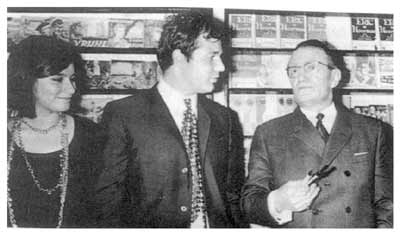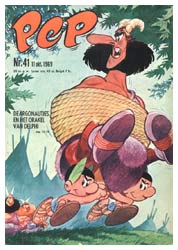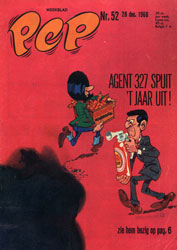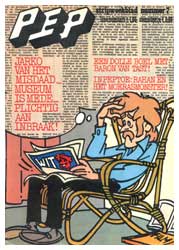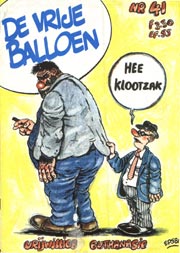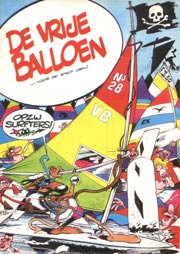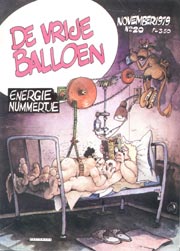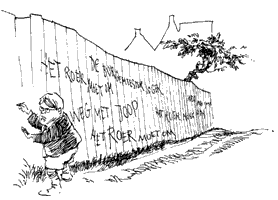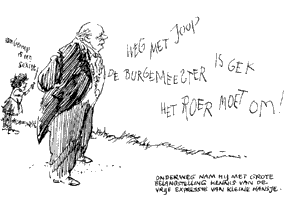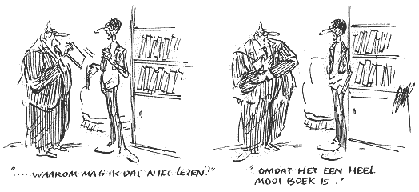Comics History
Dutch Comics 1968 -1979
By the end of the 1960s, cultural changes could also be felt in the comics world. Pop art had a distinctive influence, and there was a nostalgic interest in comics from the 1940s and 1950s, which were often reprinted and found their way to avid collectors. New French comics such as 'Asterix' byRené Goscinny and Albert Uderzo, and 'Lucky Luke' by Morris, were translated into Dutch and gave comics a more intellectual, witty image. The idea that comics were an artform that deserved to be documented, collected and preserved was given new significance.
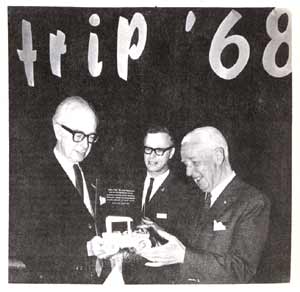
Another memorable event in 1968 was the opening of Stripantiquariaat Lambiek. Above you see owner Kees Kousemaker with his wife Evelien and Willy Vandersteen, who opened the shop on 8 November 1968. Lambiek was the first comics store in Holland, and also the first in Europe.
Very significant in this period was the comics magazine Pep, launched in 1962. After the war, most new comics were imported from the States, and were for sale much cheaper than Dutch comics. The editors of Pep decided in the late 1960s to give more room to new Dutch comic artists. Some of the best Dutch comics made their debut in this magazine, such as 'Agent 327' by Martin Lodewijk, 'De Argonautjes' by Dick Matena and 'De Generaal' by Peter de Smet.

By the end of the 1960s there was a revival of interest in comics, not only in Dutch comics but also in contemporary American comics from the American underground comix scene. Under the name Real Free Press Olaf Stoop and Martin Beumer introduced a wealth of comics to the Dutch public, including translations of underground comix and classica American comics, as well as magazines such as Métal Hurlant from France, El Vibora from Spain and Raw from America.

In 1975, another "underground" magazine was founded by Patty Klein and Jan van Haasteren. (We use the term "underground" loosely, since there never was any real censorship of comics in the Netherlands, the way there was and is in the United States of America - Dutch comic artists used underground magazines to publish work they made in their spare time and which didn't fit in more mainstream magazines). The magazine was called De Vrije Balloen and started out with artists Jan van Haasteren, Robert v.d. Kroft, Jan Steeman en Thé Tjong Khing, as well as writers Lo Hartog van Banda, Andries Brandt en Patty Klein herself. Many of the featured comics dealt with the usual sex and violence. The magazine also gave young, starting artists the chance to work with more experienced ones, and became a palying field for a new generation, including Gerrit de Jager, Wim Stevenhagen, Eric Schreurs and Paul Bodoni. De Vrije Balloen ran until 1984, after putting out 62 issues.
A typical phenomenon of the 1970s was a heightened political awareness. This was also picked up by comic artists, who started creating poignant parodies on political and social issues, both in Holland as well as abroad, especially America. Comic artist Willem wrote a comic commenting on President Johnson; Peter van Straaten mildly parodized Dutch society on a small scale in 'Het Dorp' ('The Village'); Joost Swarte drew comics against the building of the Amsterdam underground system as well as the oppression of coffee farmers in Angola; in 1977 Jaap Vegter started his one page comic in magazine Vrij Nederland, with which he comments on actual issues.
Illustrations by Peter van Straaten from his book 'Bij Ons in het Dorp' ('In Our Village').
This book is a parody on Dutch politics. In the panel above minister president Den Uijl looks sadly at the graffiti opposition leader Hans Wiegel (the brat in the village, left) has written on the walls.
Besides his political comics, Peter van Straaten started in 1968 with his famous 'Vader en Zoon' strip, about a father and son and the generation gap. The son was left-wing, idealistic and out of work, the father was right-wing, old-fashioned and conservative. Together they delighted the readers weekly Het Parool for many years.



